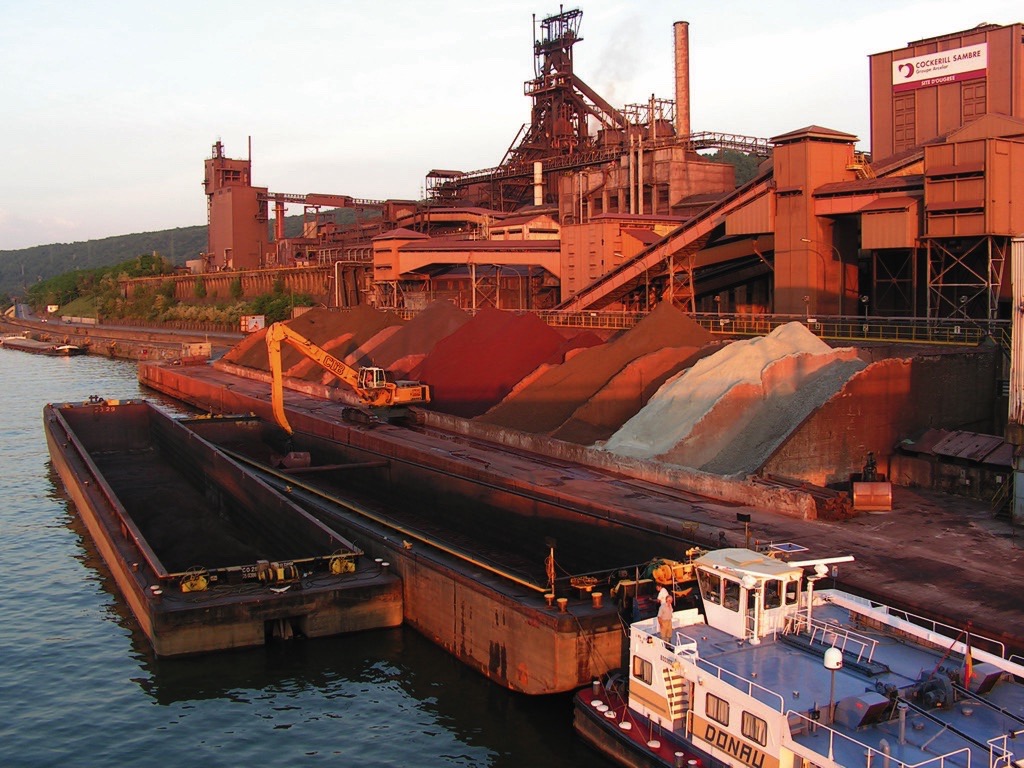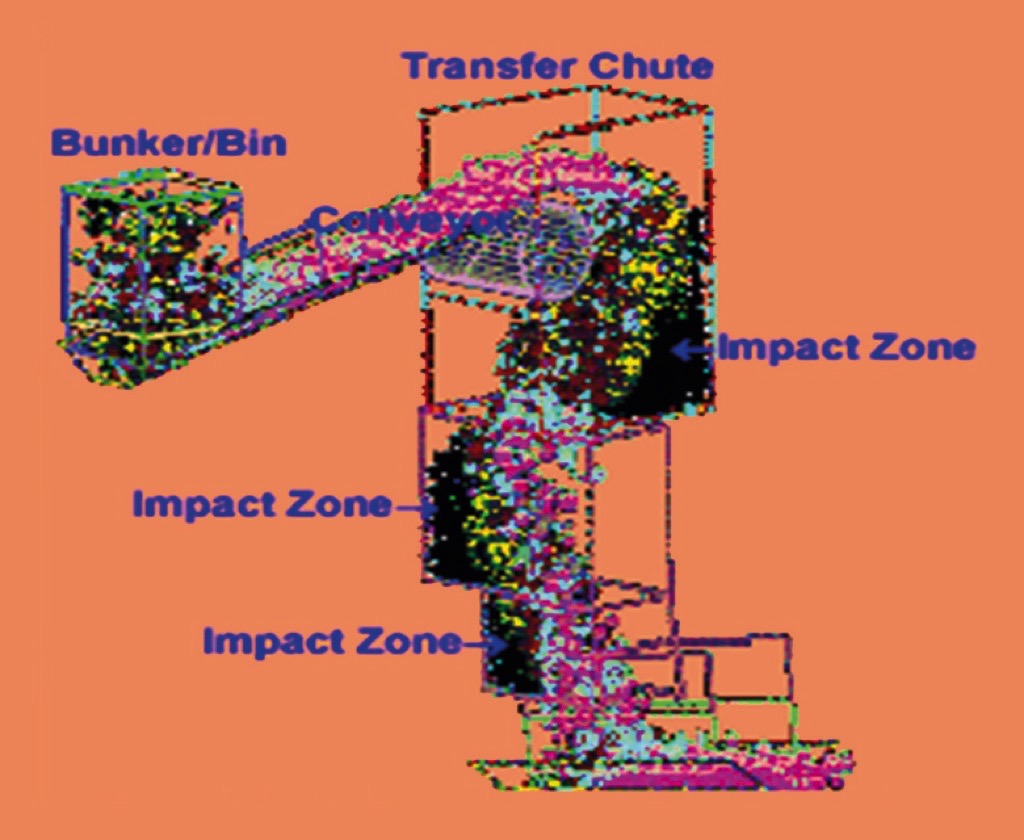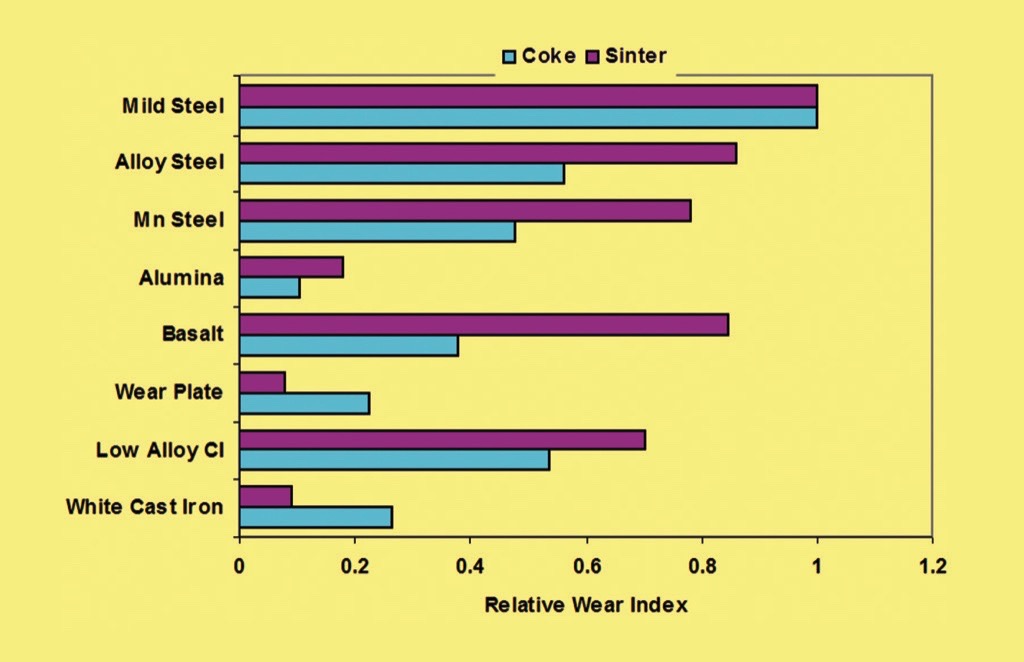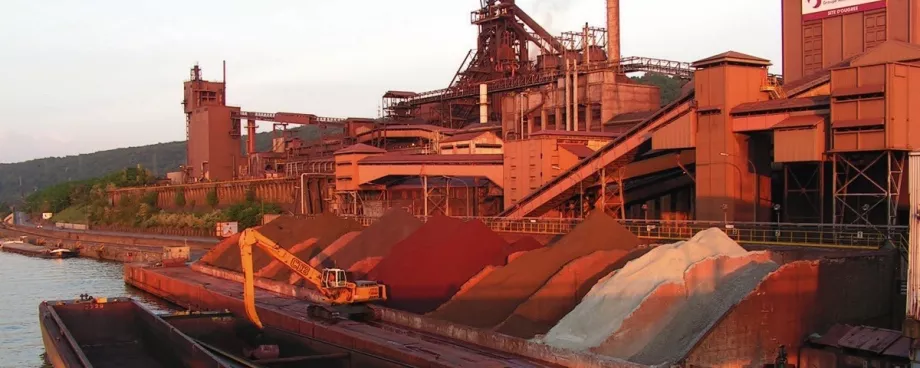(From the archive of ”bulk solids handling", article published in Vol. 34 (2014) No. 3 , ©2014 bulk-online.com)

The volume of raw materials and intermediate products handled in an integrated iron and steel plant is enormously high. Handling, storage and transportation of these materials in the preliminary stages of iron and steel production are a cumbersome task due to large volumes of different materials and their aggressive natures. The equipments in-volved in material handling such as chutes, hoppers, bins, vibrators, feeders, and bunkers are lined through their working surfaces for protection from the service attacks and to facilitate repair and replacement of the wearing surfaces. The studies undertaken to improve the performances of lining materials have revealed that high Cr-iron-alloy offers a suitable choice because of superior abrasion resistance and moderate impact condition. The service requirements of lining materials for bulk handling equipments and characteristic features of some of the new generation lining materials will be discussed briefly.
Introduction

Lining materials must fulfill a number of conflicting requirements and hence their selection and use are often dictated by a large number of factors including design and layout of the wearing surfaces of the components; characteristics of the materials being handled; various kinds of service attacks; namely abrasion, erosion, fretting, corrosion, impact and many more due to the interaction between working surfaces of liners and highly aggressive raw materials. The schematic representation of a bulk solid handling system is presented in Fig. 2.
Advances in Lining Materials
The selection and use of materials for lining applications have a chronological development. In the early days unalloyed constructional steels were being used. With the development of modern steel making technologies, the use of alloyed steel received prominence in this area. However, due to the limitations of forming of high alloyed steel, their use got restricted to certain shape and size and could not gain wide spread use.

The use of iron and steel alloys in the form of castings was accepted across a wide range of engineering industries because of the possibility of obtaining suitable alloys in desired shape and size. The research and investigations in the field of abrasive wear and the advent of newer materials have given industries a choice of selecting materials from metallic, non-metallic, composites, ceramics and polymers. The relative wear index of some of the state-of-art materials are presented in Fig. 3.The range of lining materials that can be used for combating wear in the order of minimum wear resistance first, but maximum resistance to impact, is as follows:
- Polyurethane/Ultra High Molecular Weight Polyethylene (UHMWP)
- Plain Carbon Steel
- Medium Carbon Low Alloy Steel
- Mn-Steel
- Martensitic Stainless Steel
- Tool Steel
- High Cr iron Alloy
- Sintered Alumina
- Silicon Carbide
Influence of Wear
Wear, unlike other mechanical properties, is not an intrinsic property of material but a system dependant property. The nature and extent of wear depend on the operating environment and it becomes essential for an engineer or designer to consider the operating conditions to rightly choose the material for a specific application. The properties that influence its wear characteristics can be altered and modified by employing a range of engineering treatments. It is therefore required to employ a specialist insight to select the appropriate material suitably treated to meet the requirements of a particular application. The key factors influencing choice of lining materials for steel plant applications are the degree of severity of the material being handled and the impact level (Low, Moderate, High).If the influence of temperature and velocity of movement is not considered, the abrasion/erosion wear caused by the main raw materials/intermediate products is as follows: (1) Coke; (2) Sinter; (3) Iron Ore. For the constant height of fall and nominal size ranges, the level of impact encountered by these materials in the order of highest degree is as follows (1) Iron ore; (2) Sinter; (3) Coke.It is known that the wear resistance of a material can be increased at the expense of resistance to impact and vice versa. It is often required to strike a balance between the wear resistance and resistance to impact of the lining materials to qualify for the suitability under specific application conditions. It is therefore essential to undertake the diagnosis of wear condition existing under the specific situation prior to making a choice of lining materials.The choice of materials is also governed by the ease of fabrication/forming, ease of maintenance and cost effectiveness. The most popular choices are Quenched & Tempered Medium Carbon Low Alloy Steels, Martensitic Stainless Steel, Mn-Steel, High Cr Iron Alloy (Castings & Composite Plates) and Sintered Alumina.The complete specifications for these materials, however, need to be drawn after careful consideration of the service conditions and advantages/limitations of the materials under considerations in consultation with expert agencies.In the iron and steel industry, the two most prominent lining materials for handling of coke, sinter and iron ore are high Cr-Iron-alloy and sintered Alumina.
High Cr Iron Alloy
The high Cr-ironaalloy family encompases a wide range of chemical composition with C in the range of 2.5-3.5 wt.% and Cr in the range of 18-30 wt.% as the main elements, additionally alloyed with Ni, Mo, V, W, Nb etc.. The hardness obtained after heat treatment may vary from 53-67 HRC depending upon the chemical composition and heat treatment. The microstructure consits of mainly a discontinuous network of primary carbides and a martensitic matrix. The chemical composition and heat treatment to suit the application specific requirement can be customized.The C and Cr contents (wt. %) in the range of 2-2.5 and 20-25 respectively with additional Ni and Mo each in the range of 1-1.5 may be considered for sustaining moderate impact with significant wear resistance. For a hardness of 53-58 HRC and a microstructure consisting of discontinuous network of primary carbides in a tempered martensitic matrix hardening plus tempering may be employed.The C and Cr contents can be increased to the level of 2.5-3.0 and 25-30, respectively, to increase the wear resistance, if the level of impact is low.These alloy can be obtained either in the form of castings or in the form of composite plates. The castings can be air hardened at a temperature of 1010 degree C and tempered at a temperature of 400 degree C. The typical microstructure would consist of primary carbides and tempered martensite. The composite plates are based on a hard layer of high Cr iron alloy of suitable thickness with a backup layer of mild steel or sometimes stainless steel. The hard layer could be produced by many methods including weld deposition, composite castin or sintering methods. The microstructure of composite plates typically consits of primary carbide and a carbide austenite eutectic.These alloys can exhibit 5-6 times superior wear resistance compared to the conventionally used alloys, such as Mn-steel.
Sintered Alumina
Alumina ceramic tiles can be used with varying degree of Alumina content starting from 90 to 99.9 purity level. These are the hardest of all material except diamond. These are extremely suitable for application requiring resistance to severe abrasion and impact.Depending upon the service requirement, the purity of Alumina can be varied. For most of the tribological components and for your application condition as well, Alumina purity of the order of 92-96% is sufficient. The hardness on R45N scale may be maintained in the range of 75-81.As the Alumina ceramic tiles are manufactured with powdered Aluminium Oxide by sintering process, these can be obtained in any predefined shape and size.The Alumina ceramic tiles exhibit extremely good physical, mechanical, thermal and electrical properties for industrial applications. Using >90% purity fine grained alumina with a density (Sp. Gr.) of ~3.5 g/cm³ and sintered with appropriate additions to produce a hardness of >8 Moh’s (>75 R45N) with 0 (zero) porosity may be a suitable choice for lining materials where severe wear is accompanied with temperature and chemical attack under low impact condition. These tiles may be formed with mild steel backings plates.
Conclusion
The guidelines for selection and use of liner materials have been enumerated at several occasions and have been a subject of great discussion. The choices among high Cr iron alloy, quenched and tempered steels, alumina ceramic, polyurythene, UHMWP, rubber, basalt can be made by understanding the merits and demerits of each material and requirements of the specific application conditions.
Acknowledgements
The authors wish to express their deep sense of gratitude to the management of Research and Development Centre for Iron and Steel (RDCIS), Steel Authority of India Limited (SAIL) for permission granted to pursue the work. The authors would like to acknowledge the efforts and cooperation from the laboratory staffs in carrying out the investigations. The authors would also like to acknowledge the support provided by the management of Bokaro Steels Limited (BSL) and Durgapur Steel Plant (DSP) in evaluating the performance of experimental materials.
A Note from the Editor
For all statements in this article that refer – directly or indirectly – to the time of publication (for example “new”, “now”, “present”, but also expressions such as “patent pending”), please keep in mind that this article was originally published in 2014.
Additional Readings:
- Moore, M.A.: A Review of Two Body Abrasive Wear; Wear, Vol. 27, 1974, pp. 1-17.
- Richardson, R.C.D.: The Wear of Metals by Hard Particles; Wear, Vol. 10, pp. 291-309.
- Haworth, Jr., R.D.: The Abrasion Resistance of Metals; Transactions ASM, Vol. 41, 1949, pp 189-199.
- Diesberg, D.E., and F. Borik: Optimizing Abrasion Resistance and Toughness in Steels and Irons for Mining Industry, Climax Molybdenum Company, Materials for the Mining Industry, 1974, pp 15-41.
- Norman, T.E.: High Chromium Molybdenum White Cast Irons for Abrasion Resistant Castings; Foundry Magazine, Vol. 68, 1958, pp. 128-131.
- Miller, Robert F.: Cladded Wear Plates find Mining Applications, Minetec, 1989.
- Holmes, R.E.: Selection of Materials for Lining of Chutes; 1st Intern. Chute Design Conference, South Africa, 1991.
- Lansdown, A.R., and A.L. Price: Materials to Resist Wear-A Guide to their Selection and Use; The Pergamon Materials Engineering Practice Series, Pergamon Press, First Edition, 1986.
| About the Authors | |
| K.K. SinghResearch & Development Centre for Iron & SteelSAIL - Steel Authority of India, India | |
| C. MandalResearch & Development Centre for Iron & SteelSAIL - Steel Authority of India, India | |
| R.R. PrasadResearch & Development Centre for Iron & SteelSAIL - Steel Authority of India, India | |
| P.P. SenguptaResearch & Development Centre for Iron & SteelSAIL - Steel Authority of India, India |
■







